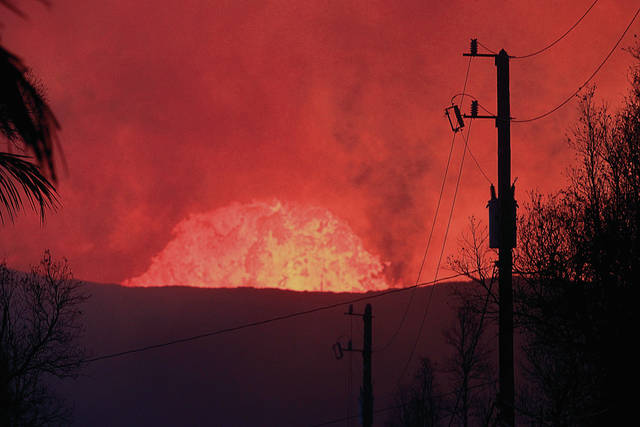Explosion shakes Kilauea’s summit

GEORGE F. LEE / GLEE@STARADVERTISER.COM
Lava pumped out of fissure 8 in this view from Luana Street in Leilani Estates on Saturday. Lava from the fissure continued to erupt at a high rate and flow to the ocean at Kapoho.
An explosive collapse at the summit of Kilauea Volcano sent a plume of steam nearly 2,000 feet into the air late Saturday afternoon.
The collapse, which produced the energy equivalent of a magnitude-5.3 earthquake, followed several hours of increasing earthquake activity in the summit area, according to the Hawaiian Volcano Observatory. A similar collapse occurred on Friday evening, also producing roughly the same amount of energy.
Meanwhile, the eruption at Kilauea volcano’s lower East Rift Zone continued mostly unabated Saturday with lava from fissure 8 feeding the open channel to the ocean at Kapoho.
According to the HVO, lava entered the sea on the southern side of the entry area, mostly through the open channel but also along a 1-kilometer-wide area.
>> Lava has blocked road access to favorite shoreline sites
>> Volcanic activity destroying marine and forest preserves
>> State leaders should be devising plans now to help volcano-impacted businesses recover
COMPLETE KILAUEA COVERAGE
>> Star-Advertiser volcano coverage
>> Kilauea Volcano YouTube playlist
Don't miss out on what's happening!
Stay in touch with breaking news, as it happens, conveniently in your email inbox. It's FREE!
HVO reported that gas emissions from the lava fountain at fissure 8 and at ocean-entry laze (acid rain) plumes remained very high throughout the day.
So-called Pele’s hair and other light volcanic glass fragments also continued to fall hundreds of meters downwind of the fissure 8 lava fountain.
Trade winds are expected to spread vog to the south and west areas of the island through the weekend.
As of Saturday evening, lava from the current eruption, which began in Puna’s Leilani Estates subdivision on May 3, had destroyed 637 homes and covered some 6,144 acres of land.
Hawaii County Civil Defense is reminding people to avoid laze at the ocean entry and monitor vog and air-quality conditions using the Hawaii Interagency Vog Information Dashboard (vog.ivhhn.org Opens in a new tab). Residents in the Volcano area are further advised to monitor gas, electricity and water connections after earthquakes.




